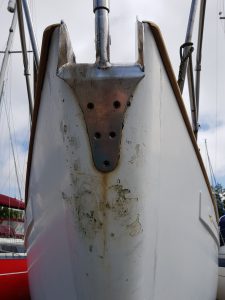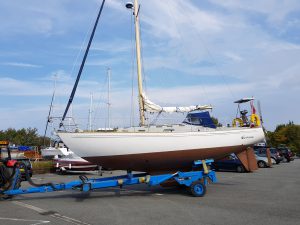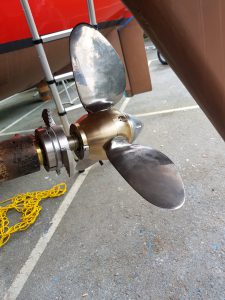There is really no point in writing this blog if I’m not honest with you. In fact, if you look up the symptoms of ADD, you will find that compulsive honesty is one of them (even though it might not be the best policy sometimes).
And there is something that I have to get off my chest. I’ve been keeping quiet about it for three months because I feel embarrassed and ashamed – but it would be worse if it were to come out and people thought I’d been hiding it.
In November I did something really, really stupid.
You may have been following my rather haphazard account of delivering Samsara from North Wales, via the South Coast to the River Deben in Suffolk. That’s where I live and although I don’t plan to keep her here (or come to that, anywhere in particular), the family did want to see the boat and I needed a destination (you do need a destination).
All had gone very well (bar the incident in Brighton when a motor cruiser hit me and cracked the brand new teak rail, carrying away a stanchion in the process). For 24 hours nobody knew who had done it. I had been ashore at the time but eventually the berthing manager spotted the culprit on the CCTV recording and he was quite happy to take responsibility. He had sent his son to check for damage and the lad reported all was well.
Anyway, the last leg was from Dover to Felixstowe – a wonderful trip because, if you time it right, you can carry the tide all the way for 12 hours. Better than that, on this occasion, I managed to get all the way there on one tack, only dropping the sails off the Landguard Buoy because by then it was pitch dark and the entrance buzzing with big ships pirouetting and pilot boats zipping between them at 24 knots.
The plan was to drop anchor somewhere up the Orwell for the night and then go round to catch the tide into the Deben the next day. Once past the glare of Felixstowe docks, the night was as black as can be – no moon and just the winking red and green lights marking the fairway. I brought my new torch on deck – high-tech and expensive with heaven knows how many lumens. I shone it out onto the water, the beam picking up the buoys as we passed. Meanwhile the plotter, dimmed as far as it would go, showed us progressing safely up the starboard side of the channel.
And this is where things went wrong. The phone rang. I remember the first time the phone rang on a boat. We were going up the Swinge off Alderney in the early 90’s. It was the weirdest sensation. But now people think nothing of the phone ringing in all sorts of place – and, of course, in cars. Now, in a car, you mustn’t touch the phone. But you can press a button on the steering wheel and have the call played through the speakers.
Well, Samsara isn’t geared up for that, but I did take it out of my pocket and start talking – after all, it wasn’t as if I was doing 70 miles an hour on a motorway. From time to time, as I chatted, I checked the plotter, shone the torch ahead, kept an eye on the buoys.
And it was during one of these checks that I was concerned to find I had wandered out of the channel to starboard. In fact, I was inshore of a line of moored boats.
“Hold on,” I said to my friend. “I’m out of the channel here. Let me get back…”
I slipped the phone into my pocket, shone the torch ahead, adjusted the course. Shone the torch again – no more moored boats – and resumed the call. Pretty straightforward, you might think. Nothing to worry about. I glanced at the plotter.
BANG!
In the glow of the steaming light, I could see a mast. I had hit a moored yacht almost head on. My bow was higher than hers and my anchor had smashed her pulpit and as, I continued down her port side, carried away two stanchions.
I won’t go into what my friend heard over the phone in the next few moments but about ten minutes later, when I went to call him back to explain, I discovered he had been holding on the whole time.
Anyway, I picked up a mooring nearby so I could inspect the damage in the morning. It was not as bad as it might have been if this had been a full T-bone collision. For my part, a weld on the pulpit had given way and there was some damage to the bow roller and anchor fixing. The anchor itself was unscathed.
Over dinner and recriminations, I considered what to write on the note I would leave on the other boat. But in the end, I called the adjacent marina and established that this was one of their moorings. They would pass on my details to the owner.
Pantaenius, who have insured my boats ever since the 1980’s, have been wonderful, of course. The owner of the boat I hit, has been very decent and thanked me for reporting the incident. Repairs are taking longer than I had hoped because of the cold weather (the engineer making a new bow roller has abandoned his workshop because it would cost more than he could make to heat it.)
Meanwhile, I have been berating myself about How Could This Happen?
First of all, there is no doubt – for me especially (see AADD above) – a mobile phone is a distraction. It’s not like talking to a crew in the cockpit. It takes you mind hundreds of miles away from where you are and even if you’re not doing 70 miles an hour on a motorway, that can have catastrophic consequences.
Even so, I knew there were moored boats around. Why didn’t I see this one? My first conclusion was that most boats have white hulls. This one was blue. The coachroof what white but – approaching from the bow – I would not have seen that. Even so, I was shining my new, high-intensity torch…
And it was only last week that I made a discovery about that torch. It has three settings: Very bright, quite bright and not-at-all bright. I would have known this if I was the sort of person who reads instructions – but what instructions do you need to operate a torch?
What I would have understood if I had read them is that the first time you switch it on, it is very bright. If you turn it off and on again, it will be quite bright. But if you are approaching a boat with a blue hull from head on and you switch on your torch when the sequence happens to have reached “Not Very Bright At All”, you might as well be without a torch at all.
This is not an excuse. It might be called a “contributory factor”. But the fault is nobody else’s but mine.
It was a salutary lesson and I promise you I shall learn from it. The main thing is that nobody got hurt and damage can be repaired.
Besides, guess what I got for Christmas: A night vision monocular.

The Old Man





I like the way you write. It flows nicely and I get to feel the essential feel of the sea. Thankyou.